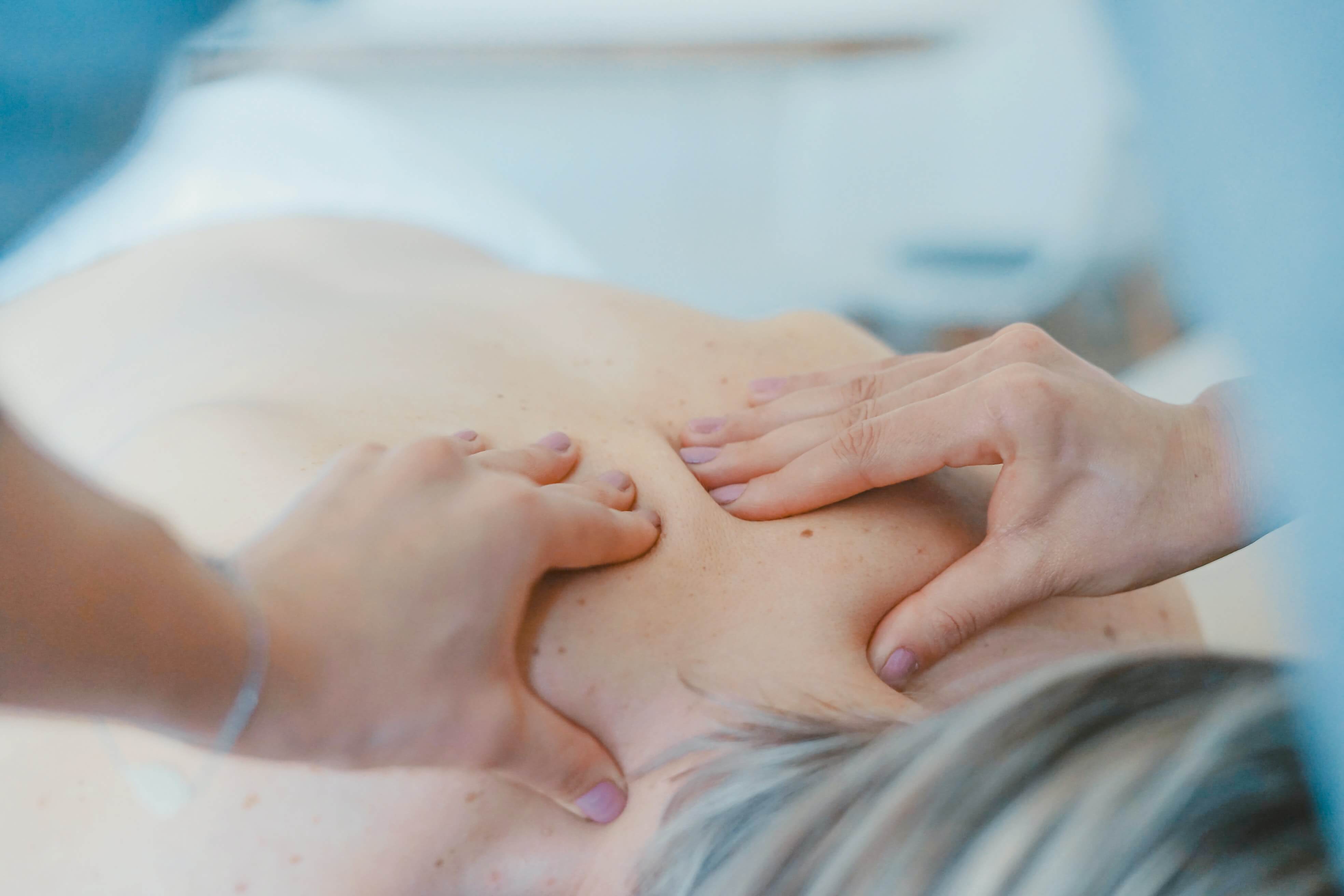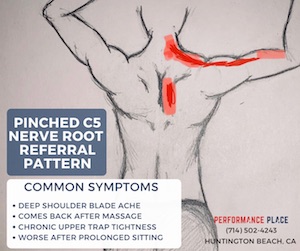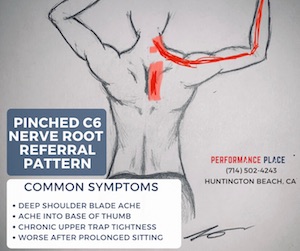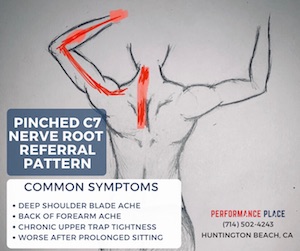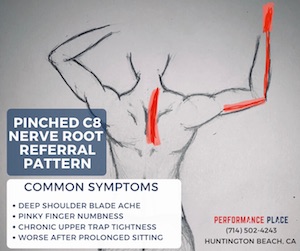Sharp Shoulder Blade Pain
If you’re reading this, it’s safe to bet you’re dealing with a sharp pain under your shoulder blade.
And if you’re like most of my clients – it’s not your first try to fix it.
Unfortunately, there are a lot of remedies out there providing little and temporary relief.
This causes hopelessness. People believe that their shoulder blade pain is a lifelong inconvenience they’ll just have to deal with.
But guess what… your shoulder pain CAN improve!. Most online blogs and remedies just deal with it in the wrong way.
47.6% of shoulder pain cases actually come from the spinal nerve.
But because they don’t feel pain in their neck or back, most people just treat the shoulder. And for almost half of shoulder blade cases, this will do nothing but cause endless frustration.
Are you part of that nearly 50% where treating your shoulder doesn’t help?
Your spine may be causing you shoulder pain, EVEN IF YOU FEEL NO PAIN IN YOUR SPINE.
This is a low risk, high reward approach, and if you’re frustrated with your shoulder blade pain, keep reading.
This article goes over the right way to deal with shoulder blade pain.
It’s likely that you’ve never heard any of this advice or associated any of these movements with your shoulder blade.
But this system has worked time and time again to relieve shoulder pain in my clients, many of whom are elite athletes.
Before You Finish…
There are effective first-aid exercises you can do NOW if you are experiencing sharp pains in the rhomboid / shoulder blade area that is not improving by addressing the shoulder.
View our web-based Shoulder Blade Guide if this sounds like you. Especially if you cannot see a sports chiropractor in person or virtually (we can do both).
Note: This article is not medical advice.
Warning: Shortness of breath, chest pain, heart disease associated pain, intense headaches, nausea, vomiting, weakness, change of hearing, speech or vision are reasons for an ER visit.
Shoulder Blade Pain Relief Program
Recovery is simple if we first address the red herring that distracts people from REAL recovery.
And what do I mean by REAL recovery? REAL Recovery means you can return to all of the sports and hobbies that you love.
It’s NOT avoiding them because you feel you’re “getting too old” or are too afraid the pain will return.
Ask yourself… what is REAL recovery to you?
Set a goal and focus on it. Set your goals high.
- Play baseball and even pitch?
- Rock climb?
- Carry your daughter around on your shoulder?
This program is going to get you there.
But first, back to that red herring…
Companies that sell foam rollers, massagers, and trigger point products want you to believe your shoulder blade pain is from a knotted-up muscle.
But they’re wrong.
This idea is meant to make consumers believe they need to roll out their muscle tension on a daily basis.
Not only does this red herring cause short-term relief and eventual frustration when the pain comes back…
It also holds you back from recovery.
Because you’re distracted by the daily routine and short-term relief, you hold yourself back from finding and addressing the root of your shoulder blade pain and eventual long-term relief.
I Want the Truth!
Your shoulder blade pain is not from overuse. It’s not from muscle strains that developed out of thin air…
That constant ache in the middle of your shoulder blades is a symptom of dysfunctional spinal levels – even if you have no neck or back pain. More technically known as non-painful dysfunctional spinal levels.
Dysfunction at the spine creates shoulder blade pain by pinching a nerve as it exits the spine.
A Shoulder Study
The idea that your spine is the cause without actual spinal pain can be hard to grasp.
Lucky for us in 2019, a study was published exposing the prevalence of spinal referred extremity pain in absence of spinal pain (i.e. no neck or back pain).
The study’s subjects were originally treated with conservative care to the region of pain without any improvement. Below are the percentages of people who significantly improved via a spinal treatment approach instead…
- Shoulders – 47.6%
- Forearm/ Arm – 83.3%
- Elbow – 44%
- Wrist/ Hand – 38.5%
- Hip – 71%
- Thigh/ Leg – 72.2%
- Knee – 25.6%
- Ankle/ Foot – 29.2%
Spinal referred shoulder pain accounted for almost ½ of all shoulder pain in the study. This means that a huge percentage of people are trying to fix their shoulder blade pain by rehabbing their shoulder, while that’s not the real issue at all.
So many people come to me saying they’ve “tried everything” with shoulder blade pain. But 99% of these people have never tried treating their spine – likely the source of the issue.
Below are examples of the most common referred pain patterns that cause shoulder blade pain.
Note that each level of the spine (C5, C6, C7, C8, and so on) has unique differences.
Although these images may not 100% describe your situation, the shoulder blade pain is a starting point before the pain starts to move outward.
C5 pinched nerve
A C5 pinched nerve tends create referred pain to the shoulder blade, upper trap and deltoid region
C6 pinched nerve
A C6 pinched nerve presents more on the outer part of the elbow and hand, towards the thumb side
C7 pinched nerve
C7 pinched nerves feel more as outer elbow pain and back of the forwarm, in addition to the shoulder blade pain
Knots and Trigger Points
Could your issue be knots and trigger points?
Sure, and these knots can be reduced with physical therapy, massage, myofascial release, foam rolling and trigger point devices.
These are what we call “compression therapies,” which is great for muscle knots, but not for nerves.
The problem is that many times these “knots” are actually pain referred from non-painful, dysfunctional spinal levels, making these compressive therapies unproductive.
When compressive self treatment doesn’t work, doing decompressive methods tend to excel! This works well with spinal disc injuries and pinched nerves, both of which can refer to the shoulder blade in the absence of neck pain.
These are simple and can be done in your own home. I’ll get into more detail later in the article.
If foam rolling and massage hasn’t worked yet, consider the possibility that your source of pain is not from knotted muscles and muscle tension.
Before you start with the home anti-inflammatory pills, you may just need to give the non-painful, dysfunctional approach a chance.
Personally, I give each treatment method a few weeks to produce a 50% reduction of symptoms. If these results aren’t found, then we simply move on to another method. The logical choice with “midback knots” is to address non-painful, dysfunctional levels of the neck and upper back..
Compressive treatments work… sometimes. Yet there are many areas of the body that do not respond to compression, the spine and nerves are perfect examples
You’ve probably already experienced nerve pressure in your life.
Have you ever hit your funny bone that sends a zinger into your hand?
This is an example of how nerves are sensitive to pressure AND how they can feel so much better after the pressure is taken away.
NOTE: If they are under pressure too long they will actually develop long term damage.
Yes, the burning/ aching sensation under your shoulder blade is not the same sensation as a funny bone experience. But nerves can reveal a variety of sensations that can result from pressure.
- Aches
- Shooting
- Burning
- Coldness
- Stabbing
- Numbness
- Creepy crawly flickers of the muscles
You name it and nerve pressure can make you feel it.
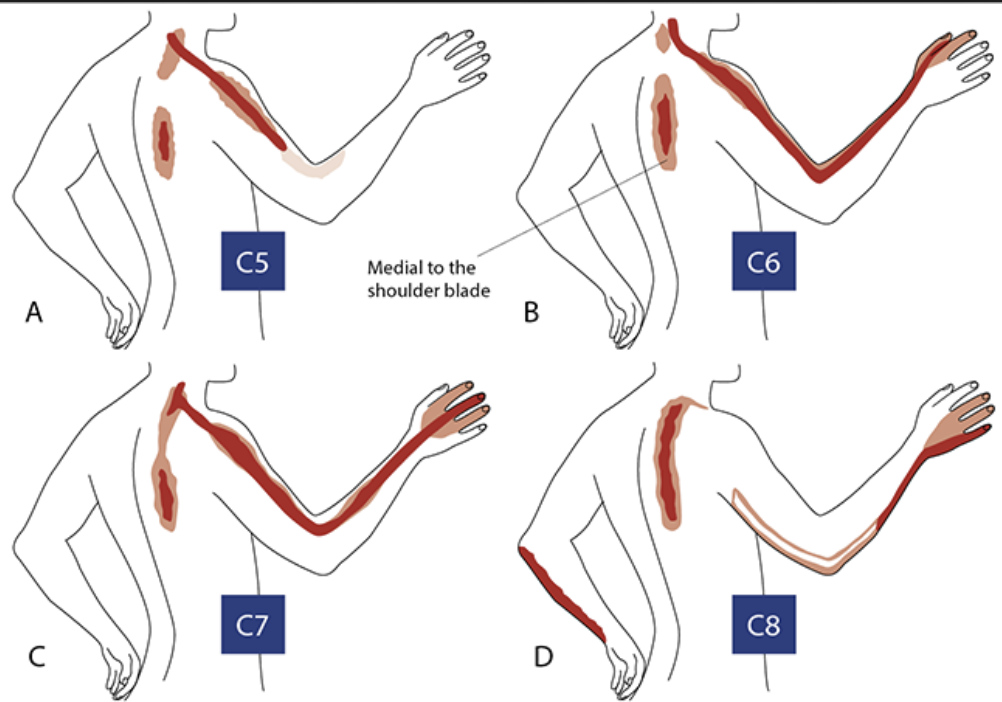
Shoulder Blade Pain Treatment
As you can see in the image from the previous section, non-painful, dysfunctional regions of the neck and upper back create a variety of presentation patterns. These odd presentations often account for pec minor tightness, upper trap tension, scalene muscle tightness in combination with the shoulder blade.
So forget what you’ve heard about foam rolling, massage and removing scar tissue from the muscles around the shoulder blade.
They just want you to buy their products.
They’re telling you that you’ll have to use their tools daily for the rest of your life to keep your symptoms at bay. They directly benefit financially when you believe your deep ache is a trigger point that needs to be rubbed away.
They benefit from the red herring.
So why does foam rolling, massage and trigger point work make you feel better?
Have you noticed the results only last for hours at most?
This is because compressive therapy tricks your nervous system and brain into ignoring the symptoms for a little while. Remember that old trick of stepping on your toe to make your headache go away… relief only lasts as long as your toe still hurts.
Compressive therapy bombards the brain with sensory information that dulls the pain.
If you’ve spent a good chunk of change on weekly massages, trigger point devices or months of successful physical therapy or chiropractic, do not be embarrassed.
Many people do the same thing before they find something that truly works for them.
And to be honest, these treatments aren’t completely useless. They still yield a few hours of pain relief right?
These treatments are amazing at pain “modification.”
They decrease pain momentarily so we can spend time addressing the real problem through MOVEMENT based correction (I’ll get into this more in a moment.)
- Your body is amazing.
- Your body has the ability to recover inherently built-in through movement.
- Movement is the body’s natural way to unpinch nerves and loosen up muscles.
It’s easy too. Simply taking a walk (relaxed with some nice arm swing) helps some people’s shoulder blade pain. Crazy right?
Other people have improvement as they start to do yard work. I know it sounds silly, but people have been surviving for centuries without foam rollers.
I’ve even told some people to push their car (in neutral) to rehab their shoulder pain… they think I’m joking, but I’m actually very serious.
Pushing a heavy object (most people just happen to have a car) can be very therapeutic and decrease shoulder blade pain when used in the strength period of their care (discussed below).
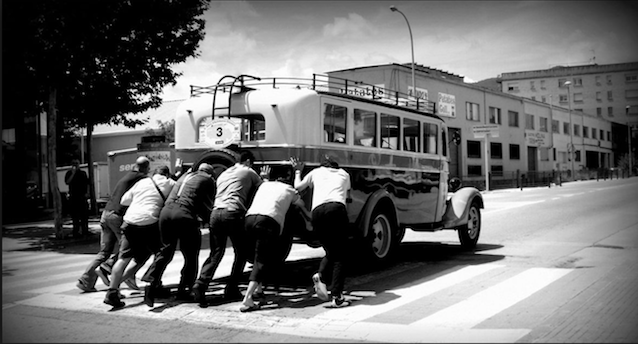
Phases of Recovery
Recovery from nerve-based shoulder blade pain comes in these phases:
- The First-Aid Period
- The Movement Period
- The Strength Period
Step 1: First-Aid Of Shoulder Blade Pain
The First-Aid Period (5-10 days)
The first aid period is exactly what it sounds like.
Just like when you get a cut, you need to rinse, clean the wound frequently, and don’t pick the scab as it heals.
With shoulder pain, it’s the same thing. Your tools and methods are just a little different.
- Use position of comfort (these can vary)
- Off load the nerve every hour for a few minutes while you’re awake
- Go for a walk (3 times a day for about 10 minutes per time)
Some movements may create symptoms, so take note and avoid them.
Here’s a video of one of the first aid moves that has worked well for my clients, especially the people who have “psuedo rotator cuff syndrome”/ strains.
It’s called McKenzie Cervical Extension. It’s important to note that it’s a GRADUAL reduction and centralization of symptoms that I look for to validate this as a good first-aid for this person.
The first few may be tender, but as the reps increase it will do one of two things… make it more painful (in the blade) or reduced.
If reduced, great! If not, then we would find another form of first-aid.
Not all first aids are created equal. The whole idea that there’s a “single exercise or treatment” that will work for everyone is complete BS. This specific first-aid is 1 of 6 first aids we include in our guide.
Make notes of observation and patterns that develop. What seems to trigger your symptoms?
In the movement period, we start to re-integrate the triggering movements to become pain-free again.
Pain is a positive feedback loop and will feed itself if you let it.
This phase assists in breaking that loop, so we can exit the symptom cycle.
Step 2: Movement Period For Shoulder Blade Ache
Now we’ll start to explore free ranges of motion – without adding too much of a load challenge.
- Walking
- Jogging
- Arm circles
- Leg circles
- Movement flow
You shouldn’t overthink this step, just start moving.
If the symptoms return, then change that movement’s range. Perhaps you weren’t ready for that much of THAT MOTION yet.
Don’t worry. You will more than likely be able to regain most of your motion back, if not all of it. Your body is very resilient.
Movement is medicine. Sometimes the medication is too much too soon.
Step 3: Strength Period
This is when the pain is gone. We don’t have the fear that it’ll immediately return. We’ve gained back most, if not all movements of the neck, shoulder and midback.
Oftentimes, the missing link (to gain more symptom-free motion) is the incorporation of some strength and support to the areas moving… the neck, shoulder and midback.
Funny though, in this period most people feel much better, so they tend to shy away from “making it worse.”
But the lack of building strength and support around the spine is the reason WHY many people will have the same issues come back year after year, till they sadly start to tell themselves they are “broken” or “getting old.”
Depressing way of thinking huh?
Getting Back After Recovery
After relief, we’re excited to get back to the things we love. But we still have that fear that the shoulder pain will return.
How can we be sure the neck can move and tolerate activities we love without becoming pinched again?
Simple, the neck moves better/more freely when it’s surrounded by stable areas.
So the key to beating shoulder pain for good is to build the strength of the shoulder blade, anterior neck and deep core. (Notice I said strength, NOT size).
The mid back (thoracic spine) is important as well. It functions less as a point of strength and more of a section of “attention.”
The mid back will strengthen while strengthening the shoulder blade and core. It’s almost like a bonus.
Adding load (resistance) to movements is actually therapeutic.
Sadly, much of the general public thinks of resistance training as ways to lose weight or “get big like Arnold”… yet those are just extreme side effects.
They occur when people “double down,” work really hard and spend more than a few hours a week partaking in weight training. It takes YEARS of hard work to boot.
I encourage you to get with a strength coach and start lifting weights. The weights don’t have to be extreme either. To get therapeutic benefits just make it “a little challenging.”
The Next Step to Recovery
If you only remember three things from this article, let it be this:
You can do this.
Your body is not broken.
You’re not too old.
I hope this article did its job in helping you understand the real cause of your shoulder blade pain and the route to REAL recovery.
But there’s one more thing I want to leave you with.
I see this mistake in my clients again and again… and I think it’s safe to say that it is the biggest mistake people make with shoulder blade pain.
I created a free audio to illustrate to you what the biggest mistake is. It’s something we all instinctively do with shoulder blade pain, and I’ll explain why you should stop.
Sign up below to receive this free audio!
A Success Story For Pain Under Shoulder Blade
Becky was able to successfully return to full activity (work, yoga and sleep) after suffering from shoulder blade pain like you.
Becky has been a nurse for the past 10 years, working in a hospital 5 days per week.
She’s fully capable of rolling patients over in bed, pushing wheelchairs, and going throughout her day without neck, shoulder blade, or arm pain. She sleeps like the dead at night without the assistance of medication of any kind.
But she didn’t always feel this good…
10 years ago, Becky was in grad school when she started to develop light headaches and muscle tension.
Most days were mild, just a light throbbing ache around the base of her head. Other days her headache would wrap around her head, towards her eyes and travel downward towards her shoulders.
She got through most of the day with help of a frequent self massage and bi-weekly chiropractic work to address her muscle tension Her home remedies included weekly anti-inflammatory medication and rolled on a tennis ball.
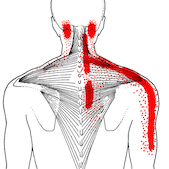
A few years later, her symptoms began to evolve.
Even though she feels great today, she can still recall the details like it was yesterday.
Most days she was in intense pain from the moment she opened her eyes in the morning. Sleeping was terrible due to the fact that it felt like someone was taking a hand drill and boring a hole into her right arm bone all night, directly through her bicep.
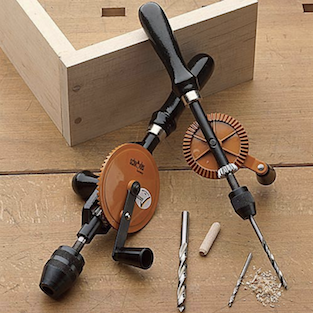
Throughout the day, her pain began to increase and creep down into her midback, upper trap area and to both of her shoulder joints. The pain was so intense at times that she said she would have been “willing to cut her arm off” if it would take the pain away.
She had to stop doing yoga, was unable to sleep at night and considered quitting her job. She continued to use anti-inflammatory medication and tennis ball rolling as home remedies. She was doing this daily now.
She did not have any shortness of breath, yet deep breaths would hurt between her shoulder blades. She did not have chest pain. Searching the Internet brought her to Dr. Google, which said she was simply experiencing intense muscle strains.
Tucking her chin and looking upward at the sky were painful. Looking down to her chest was much better, but still not pain-free. While driving, she could not turn her head to check for cars as she changed lanes. She even bought those little blindspot mirrors so she could safely change lanes.
Sounds intense right? Yet, she was able to overcome it.
What did she do to feel better?
She didn’t get better overnight. She spent months having her neck adjusted, going to physical therapy (ice and muscle stimulation machines) and getting massages with very temporary relief.
Eventually she found a chiropractor specializing in focal soft tissue work to help her release a nerve in her neck and shoulder. After that she began to progressively get better.
A series of thoracic mobility and shoulder blade stability exercises were suggested, along with daily walks at sunset. Using this series of home remedies, she was able to avoid being seen weekly for soft tissue work to release her neck.
Once she found specific exercises that worked for her, she was able to sleep without being woken up by pain. She was even able to return to yoga without any restrictions.
Want to be like Becky?
Sign up for the 12-Week program for the REAL recovery that Becky and many others have experienced.
Click here to get the program:

